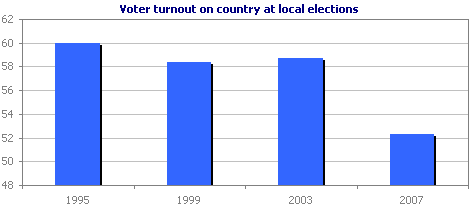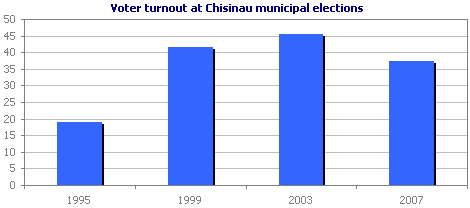ADEPT | Gagauzia 2016 | Presidential 2016 | Elections 2015 | Bashkan 2015 | Gagauzia 2012 | Political Parties
Voter turnout at June 3, 2007 elections
The generalised results of the June 3, 2007 elections unveiled by the Central Electoral Commission (CEC) on June 6 have generally coincided with the results made public after the closing of polling stations by those who performed a parallel counting. However, there is a significant difference between the final results regarding the voter turnout released immediately after the closing of polling stations. Therefore, a number of conclusions made after the elections shall be reviewed.
Number of citizens entitled to vote vs. number of electors from voters’ rolls
A fair voter turnout shall be established in order to validate the results of elections. The voter turnout depends on how accurately the voter’ rolls are issued. Under the Electoral Code, the CEC has sought and obtained the publication of data on total number of electors — 2,449,164 people — on March 1, 2007. This figure shall be compared with the one from the March 11, 2005 CEC report released after the parliamentary elections. The CEC said then that 2,270,668 people were included in basic lists and another 159,869 electors in additional voters’ rolls. Certainly, the rise of the number of voters by 18,627 people in 2007 compared with 2005 is not an effect of demographic processes but it is rather due to the modification of Article 22 of the Electoral Code, which stipulates that the Ministry of Information Development “ensures the record of electors, including of those outside of the Republic of Moldova on basis of the state population register.”
Earlier, the CEC did not seek for sure the inclusion of citizens working abroad in the basic voters’ rolls. This attitude aimed to prevent the invalidation of elections because of eventual absenteeism, with the threshold for parliamentary elections being ½ of people from voters’ rolls and 1/3 of people for local elections. Amendments to Articles 22 and 136 of the Electoral Code imposed on one hand the inclusion of all citizens in voters’ rolls, inclusively of those working abroad and on the other hand lowered the threshold for local elections from 1/3 down to ¼.
According to the results unveiled by CEC on June 6, 2007, 2,219,177 electors were included in basic lists for election of second-level local councils and 86,595 electors were introduced in basic voters’ rolls for election of first-level local councils in Gagauzia (citizens from Gagauzia do not elect second-level councils). The sum of these two figures — 2,305,772 people — should coincide with the number unveiled by CEC on March 1, 2007. However, it does not coincide and the difference is significant — 143,392 voters or 5.8 percent.
Accuracy of voters’ rolls
The only plausible explanation to discordance between these numbers may be linked to inaccurate voters’ rolls issued by mayoralties and delivered to electoral offices of polling stations for elections. This supposition is also correlated with the high number of electors included in additional rolls: 84,202 voters or 3.8 percent in second-level constituencies and 5,799 people or 6.7 percent in Gagauzia. Overall on country, 90,001 electors or 3.9 percent were included in additional voters’ rolls. This result is better than the one registered in 2005, when 7 percent of electors were included in additional voters’ rolls, and better than in 2003, when 4.5 percent of electors were included in additional lists. This seems to be a significant and even impressive progress in the Chisinau municipality. Thus, approximately 1.5 percent of electors were included in additional voters’ rolls at the November 2005 new local elections in Chisinau and the voter turnout at the June 2007 local elections was approximately 2-fold higher and 9,870 electors or 1.7 percent were included in additional lists.
If adding 90,001 electors from additional lists to those included in basic voters’ rolls for second-level constituencies and for Gagauzia, we will find out that Moldova has 2,395,773 electors indeed. The difference between the last number and the figure unveiled by CEC on March 1, 2007 counts for 53,391 people. As more than half of electors have attended the elections, we may conclude that the number made public by CEC on March 1, 2007 is very close to the real number of citizens entitled to vote. This would be if admitting that the eventual participation of the half of electors who do attend the elections would produce a proportional rise of the number of electors included in additional voters’ rolls. Truly, it seems reasonable to count 53,391 potential uncalculated electors per 48 percent of absentees, if 90,001 uncalculated electors count for 52 percent of participants in elections.
These explanations are needed to prevent talks on alleged fraudulent manipulations with voters’ rolls. Also, it shall be taken into consideration that the comparison of voter turnouts produces conclusions regarding the protest potential of citizens. For example, it was initially announced that the turnout on country was only 48 percent at the June 3, 2007 elections. In comparison with 58.7 percent at the 2003 local elections, the difference of more than 10 percent of voter turnout is too big to be unobserved and unexplained. Final results unveiled by CEC revealed the best turnout, notably 52.3 percent, reducing the importance of absenteeism phenomenon in interpreting the results.

Continuous rise of number of electors in Chisinau municipality
It was established that the number of electors included in basic voters’ rolls continues to grow significantly in the Chisinau municipality, notably 581,415 electors in 2007, compared with 536,777 in 2003, it means by 44,638 more voters, 8.3 percent. This is a remarkable fact because the electoral statistics on Chisinau municipality has a strong impact on electoral statistics on country, with the number of electors in Chisinau counting for 25 percent of all voters.
At least three reasons explain the higher number of electors in capital: 1) Chisinau remains the most attractive locality where citizens who come back home after working abroad and their relatives move to; 2) modification of Article 9 of the Electoral Code, which regulates the voting at residence place, imposes the inclusion of approximately 40,000 students from hostels in voters’ rolls; 3) modification of Article 22 of the Electoral Code requires express the inclusion of citizens working abroad in voters’ rolls.
These observations linked to conclusions drawn from the high absenteeism rate are especially effective for elections in the Chisinau municipality. So, a turnout of approximately 30 percent was reported immediately after the closing of polling stations, but it was established later that 37.2 percent of people entitled to vote have cast their ballots.

Turnout in absolute figures
The absolute voter turnouts at the 2003 and June 2007 local elections must be compared to make a clear impression about absenteeism rate. Thus, though the absenteeism must be remarked, it is one of multiple factors needed to explain the electoral conduct at the current elections compared with the 2003 scrutiny:
In country — 1,293,955 electors received ballot papers in 2003, compared with 1,205,704 electors in 2007, the difference being of 88,251 voters or 6.8 percent;
In Chisinau — 253,788 electors received ballot papers in 2003 compared with 219,820 in 2007, the difference being of 33,968 voters or 13.4 percent;
In Gagauzia — 46,418 electors received ballot papers in 2003 compared with 50,629 voters in 2007, with their number growing by 4,211 people or 9 percent.
Conclusions
The report on record of citizens entitled to vote worked out at central level and made public on March 1, 2007 is relatively satisfactory;
The issuance of voters’ rolls by local administrations leaves much to be desired and, therefore, a more consistent assistance of central administration is needed;
The absenteeism as a protest conduct form is especially manifested in the Chisinau municipality. By contrast, the appreciable growth of turnout in the Gagauzia constituency at the recent local elections reveals that the “change” that took place in the Gagauz autonomy half a year ago has a positive impact on voter turnout.


